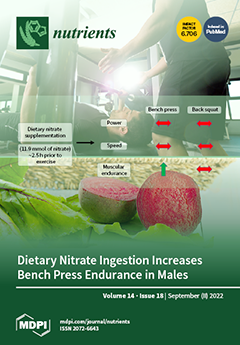This study aimed to evaluate the consumption of dietary supplements (DS) and to determine related topics in Turkish football players of different sexes and competition levels. A total of 117 footballers (79 males and 38 females) completed a specific survey regarding DS consumption in athletes. The type of DS ingested was classified based on the level of scientific evidence by the Australian Institute of Sport (AIS): group A (high level of scientific evidence), group B (DS that could have a positive effect, but require more evidence), group C (evidence is against their use), and group D (prohibited substances). After a Kolmogorov–Smirnov test, a
t-test or Mann–Whitney U test was performed for quantitative variables, while Pearson’s chi-square and odds ratio (with the confidence interval) were performed for qualitative variables. Of the sample, 87.2% reported having consumed DS, with a higher consumption rate in males (males: 93.7%, females: 73.7%;
p = 0.006; OR = 5.3 [1.7–16.8]) and professional players (professional: 98.2%, non-professional: 77.4%;
p < 0.001; OR = 7.9 [1.2–52.3]). Males and professional players consume more sports foods (
p < 0.001), performance supplements (
p < 0.001), and total group A supplements (
p < 0.001) compared to females and non-professionals. In addition, males consume more medical supplements (
p = 0.012) and total group C supplements (
p < 0.001) than female footballers. The most consumed DS were sports drinks (63.2%), magnesium (52.1%), vitamin C (51.3%), vitamin D (46.2%), caffeine (38.5%), sports bars (37.6%), whey protein (28.2%), meat protein (25.6%), vitamin E (24.8%), and omega-3 fatty acids (24.8%). The supplement consumption was higher in male and professional footballers. According to the AIS classification, there were significant differences in the consumption of sports foods, medical supplements, performance supplements, and the total number of group A and group C supplements according to sex, and there were significant differences in the consumption of sports foods, performance supplements, and the total number of group A supplements according to competition level.
Full article






